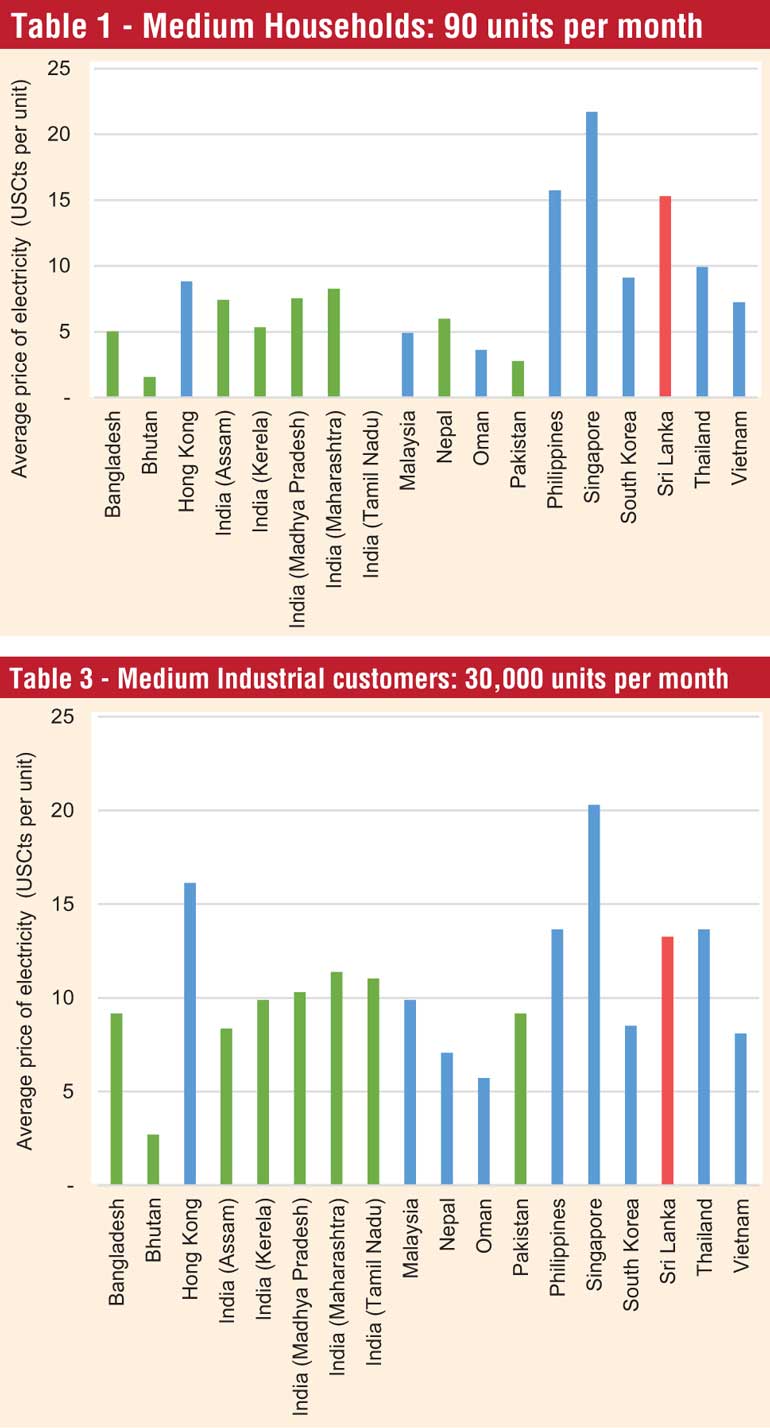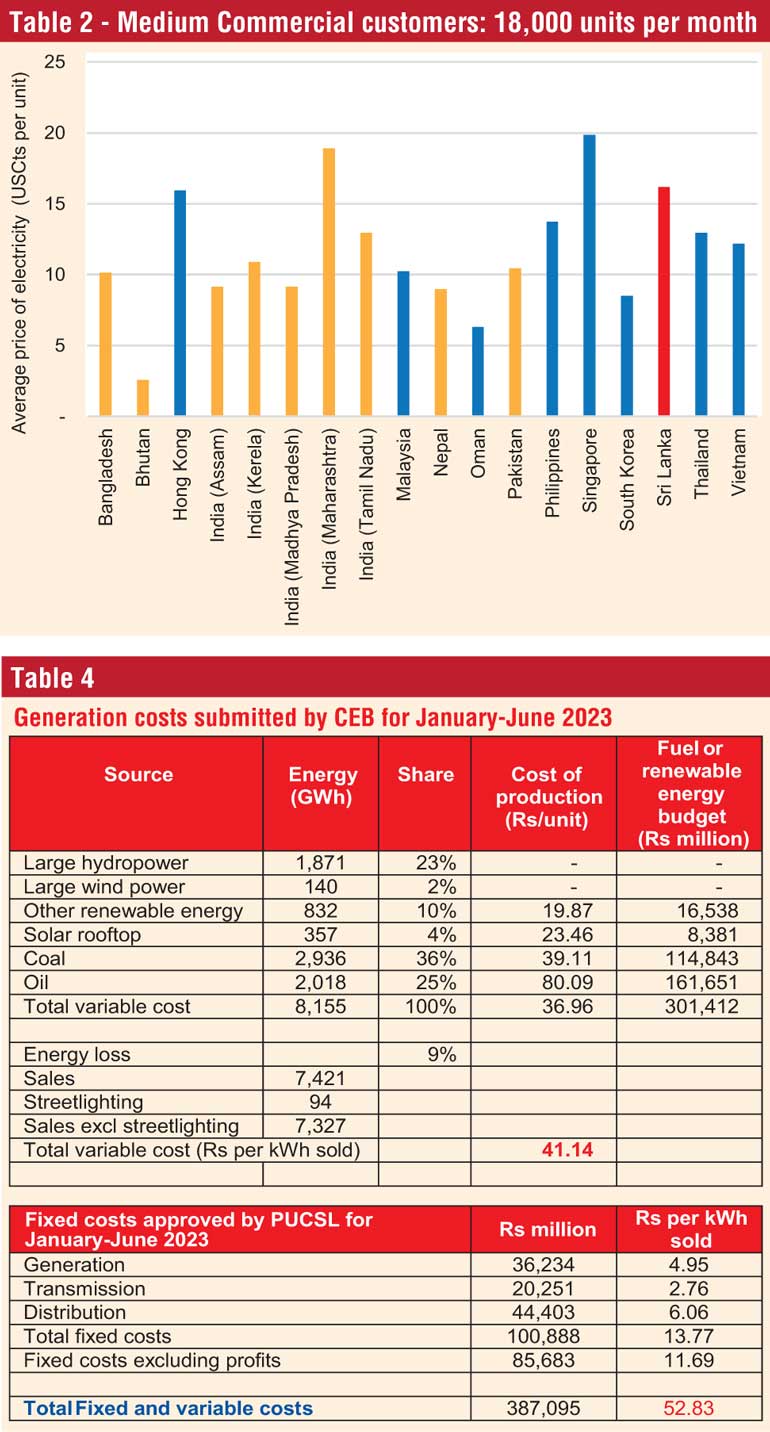Monday Apr 28, 2025
Monday Apr 28, 2025
Tuesday, 27 June 2023 00:10 - - {{hitsCtrl.values.hits}}

 In February this year, Sri Lanka’s national average price of electricity was increased from Rs. 30 to Rs. 48 per unit of electricity. Fierce, sometimes baseless, arguments were heard even in Parliament, about the per cent increase to various categories of customer. Subsides that were up to 85% of cost to certain household customers were reduced in February to about 30%. Surcharges on high users remained. There was no explanation of costs, either by CEB or PUCSL, to serve each type of customer and the subsidy they enjoyed. There were questions all over, most of which remained unanswered. In the end, everybody got a price increase, now paying unprecedentedly high prices in the history of Sri Lanka. Not only in rupee terms, even in dollar terms.
In February this year, Sri Lanka’s national average price of electricity was increased from Rs. 30 to Rs. 48 per unit of electricity. Fierce, sometimes baseless, arguments were heard even in Parliament, about the per cent increase to various categories of customer. Subsides that were up to 85% of cost to certain household customers were reduced in February to about 30%. Surcharges on high users remained. There was no explanation of costs, either by CEB or PUCSL, to serve each type of customer and the subsidy they enjoyed. There were questions all over, most of which remained unanswered. In the end, everybody got a price increase, now paying unprecedentedly high prices in the history of Sri Lanka. Not only in rupee terms, even in dollar terms.
National average consumption of a household is a pittance of 70 units per month. Even for household customers using 90 units per month, Sri Lanka’s price is the highest in South Asia, and only 3rd in Asia, behind Singapore and the Philippines.
For commercial customers, Sri Lanka’s prices are only second to Tamil Nadu, the state that provides a very large subsidy to households, using the very high income from sales to commercial customers. Here too, we are now the third in S and SE Asia.
The agony of industries is even worse. Sri Lanka has the highest price of electricity for industry in South Asia. Along with all other constraints, electricity costs too are a reason to drive industry away from Sri Lanka. Sales to industries have not been growing for some time, even before the economic crisis. Sales to industries dropped by 10% in 2022.
52% of Sri Lanka’s electricity in 2022 was produced from renewable sources. Not only in percent terms, but by way of units of energy, too, Sri Lanka produced the highest ever amount of electricity from renewable energy in 2021. The second highest amount ever of 8,400 million units from renewables in 2022.
How do neighbours produce electricity
India produced only 22% of her electricity from renewables but provides electricity cheaper than in Sri Lanka to almost all customers. The balance of electricity comes from coal and LNG. Philippines is similar. Thailand produces a mere 13% from renewables but provides electricity cheaper than Sri Lanka. All of Thailand’s balance electricity is produced from fossil fuels: LNG and coal, both procured at correct prices. Malaysia, with a population similar to Sri Lanka feeds 12 times the electricity used in Sri Lanka to her economy at prices well below that of Sri Lanka. How? Using LNG and coal to produce electricity.
What is more? Sri Lanka’s total electricity requirements by way of units of electricity decreased by 41/2% in 2022. The demand for electricity measured in megawatt including electricity served by distributed renewable energy, is now 2,500 in 2023 against 2,800 megawatt reported in 2022. This means, customers have reduced their consumption at least by 300 megawatt. A good 10% reduction. However, the demand overnight has shown a more drastic reduction from 1,700 to 1,200 megawatt. A reduction of 30%. Households or commercial customers do not use electricity late night. So, all this 30% reduction is from industry. In other words, manufacturing industry is down by 30% today, compared with a year ago.
A Sri Lankan uses a very small amount of electricity for household and all economic activities. In 2022, it was 700 units of electricity per person. In Norway, the consumer highest in the world continuously for 30 years, it was 25,000 units. Countries that preach energy saving and emission reductions to Sri Lanka, all used 12,000 units per person or more per year. A Sri Lankan used a pittance of just 700 units. So where is the problem? It is easy to blame the present administration, PUCSL, CEB, LECO, other countries or many individuals for the high prices. Much of the talk heard, including by Chambers representing both renewable energy suppliers and users of electricity, do not address the specific problem of Sri Lanka’s electricity supply.
Barking up the wrong tree
All think that breaking CEB into 15 pieces will solve the problem. The answer is no!
Many politicians and professionals alike, and the common man too, assume that selling off CEB and LECO will solve the problem of high electricity prices in the country. Wrong? That may solve some other problem but it will not solve the problem of the price of electricity supply. If CEB was already a private entity, the price of electricity would have been Rs. 56 per unit by now (not Rs. 48 as I said earlier), when the legally allowed profits to its private owners are added. CEB makes no profit even by selling at Rs. 48, according to PUCSL. Sack PUCSL chairman? No, it will not solve the problem. Change the Minister? Bring a new Electricity Act? Sack CEB Chairman, break CEB into 15, reduce staff by 50%, issue e-bills? Such actions will not solve the key problem: the problem of high electricity prices.
We must remember that prices are high because costs are high. Easy to say the Government must subsidise. That’s what was going on from 2014 to 2022 across many governments, Yahapalana or otherwise, that ruined not only CEB but CPC, too. Subsidies were promised but not fulfilled. Then they killed the renewable energy supply industry, too, whose bills have not been paid for over one year.
So, what are the costs and how can they be reduced? (Refer Table 4).
The cost of supply without profits is Rs. 52.83, but customers are charged Rs. 48 per unit.
So the largest single cost item is Rs. 41.41, which is the average generation cost. All fixed costs, except distribution, are in the internationally acceptable range. Among the generation costs, the cost of fossil fuel is baffling.
Cancelled power projects
Going back to 2015, looking at the approved plans at that time, if the power plant projects listed there were implemented, Sri Lanka would have sold electricity in the first half of this year at Rs. 38 instead of Rs. 48. That means your bills would have been 20% lower than what you have been paying since February.
Now with further reduced costs of fuel, when the price revision is done on 1 of July, your electricity bill would have dropped by Rs. 17, from the present Rs. 48 to Rs. 31, which is a 35% reduction in your bills. Even with the “inefficient” and “state-owned” CEB, electricity prices would have been 35% lower from 1 July this year, only if the correct power plants were allowed to be built.
Sadly, the following projects and processes were cancelled by your past Presidents over 2015-2022: Sampur, Norochcholai No. 4, gas terminal, competitive bidding for various renewable energy power plants. New contracts for renewable energy are being signed at Rs. 37 or more, whereas most countries have firmly gone for competitive bidding. But in Sri Lanka, no way! No competition, but simply lobby and get the prices increased.
Still not too late
So it is a case of mixed up priorities, wrong decision-making or indecision. To the credit of CEB, the country has a long-term power generation plan to reduce generation costs. The problem is that it is not allowed to be implemented.
Leaders of the distant past took credit of leading the construction of power plants to produce cheaper electricity. Leaders of the last two decades take credit of changing plans and cancelling power plants.
If the cancelled or sabotaged projects of all types are revived and implemented with diligence and a sense of urgency, Sri Lanka’s electricity prices can be reduced to below the level of India’s prices or Bangladesh’s, within four years. Why? Because 50% of our electricity already comes from renewables, which must be cheaper than fossil fuels.
Sadly, there are no such moves, at all. The only talk is about breaking CEB into 15. That will not produce cheaper electricity.
The trend is to build more diesel power plants, cancel cheaper power plants, go to seminars abroad and promise not to build various cheaper power plants, manipulate gas terminal contracts (New Fortress!), sign contracts to buy wind power in US dollars, increasing prices paid to renewable energy, and in general, total violation of the plan and the principles of competition.
No amount of reforms or privatisation will bring the prices down, if Sri Lanka goes in this destructive path of using more and more diesel and non-competitive procurement of renewables. The remaining manufacturing industries too will go away to countries with cheaper energy and better strategies. Those countries are not too far away from Sri Lanka.
No amount of sacking of PUCSL Chairmen will bring the prices down, unless true competition in procurement is re-established, to build power plants to bring prices down. That needs hard decisions.
Sadly, politicians, media, the learned and others all believe in the untruth and lies on how other countries produce their electricity.


Discover Kapruka, the leading online shopping platform in Sri Lanka, where you can conveniently send Gifts and Flowers to your loved ones for any event including Valentine ’s Day. Explore a wide range of popular Shopping Categories on Kapruka, including Toys, Groceries, Electronics, Birthday Cakes, Fruits, Chocolates, Flower Bouquets, Clothing, Watches, Lingerie, Gift Sets and Jewellery. Also if you’re interested in selling with Kapruka, Partner Central by Kapruka is the best solution to start with. Moreover, through Kapruka Global Shop, you can also enjoy the convenience of purchasing products from renowned platforms like Amazon and eBay and have them delivered to Sri Lanka.
Discover Kapruka, the leading online shopping platform in Sri Lanka, where you can conveniently send Gifts and Flowers to your loved ones for any event including Valentine ’s Day. Explore a wide range of popular Shopping Categories on Kapruka, including Toys, Groceries, Electronics, Birthday Cakes, Fruits, Chocolates, Flower Bouquets, Clothing, Watches, Lingerie, Gift Sets and Jewellery. Also if you’re interested in selling with Kapruka, Partner Central by Kapruka is the best solution to start with. Moreover, through Kapruka Global Shop, you can also enjoy the convenience of purchasing products from renowned platforms like Amazon and eBay and have them delivered to Sri Lanka.